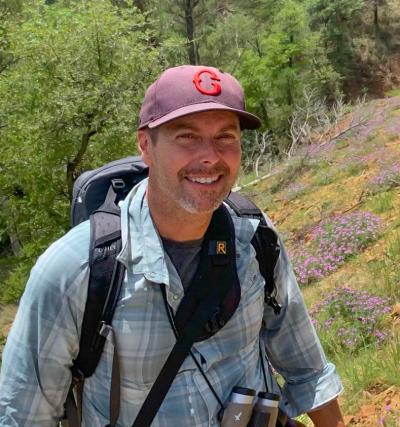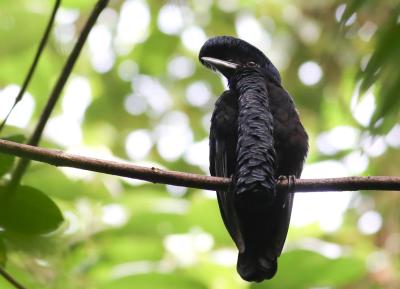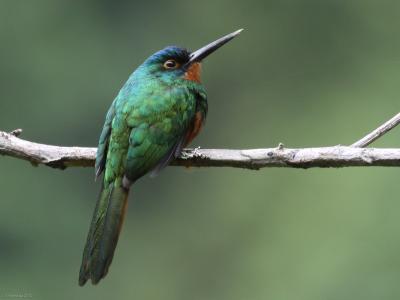Ecuador: Mindo and the Northwest Andes
-
Feb 3-11, 2025
Jon Feenstra
The Andes of western Ecuador have some of the best and most accessible birding locations in all of South America, and the wonderful Séptimo Paraíso Cloud Forest Reserve in Mindo is a prime example. While one-stop Ecuador tours will produce fewer species than a multi-week, all-country blitz, even a short tour based at a place like Séptimo Paraíso offers a superb combination of remarkable close-at-hand bird diversity and the inherent convenience of birding from a single comfortable base.
Séptimo Paraíso Lodge is comfortable indeed, with its own restaurant, spring-fed pool, spa, and support services. It is delightfully situated in the Mindo Valley and has great birding right on the grounds, as well as being an excellent base from which to explore surrounding areas. Among the birding localities we’ll visit, most of them along easily walked roads and trails, are the Tandayapa Valley, Mindo, the Paz de las Aves reserve, and the forest preserves at Milpe, Silanche, and Amagusa—all of them within 15 minutes to 1.5 hours from the lodge. During our seven days of birding we should encounter about 300 species, possibly including some of western Ecuador’s most celebrated: Giant Antpitta, Toucan Barbet, Plate-billed Mountain-Toucan, Ocellated Tapaculo, Andean Cock-of-the-rock, Rufous-tailed Jacamar, Club-winged Manakin, Indigo Flowerpiercer, Tanager Finch, and as many as 40 species of hummingbirds and 50 dazzling tanagers.
This tour can be taken in conjunction with our Ecuador: The East Slope of the Andes and Ecuador: The Amazon Lowlands I tours.
Day 1: The tour begins at 6:30 p.m. in Puembo near Quito’s international airport. Night in Puembo.
Jon Feenstra is an excellent guide: professional, organized, caring and a good companion. The tour was well-conceived and organized, with a balanced program of walks and stationary observation. We saw a wide variety of birds, along with a few rarities. Very exciting. -Angelo A.
Day 2: We’ll leave early this morning for Yanacocha Reserve on the Pichincha Volcano. Located in temperate cloud forest, Yanacocha is home to a number of interesting high-elevation species. We’ll watch the hummingbird feeders for the amazing Sword-billed Hummingbird, Buff-winged Starfrontlet, and Great Sapphirewing. Tanagers are abundant at this elevation, and we’ll hope to find such mountain-tanagers as Scarlet-bellied, Hooded, and possibly the rare Black-chested. We’ll then descend below the town of Nono through relatively untouched temperate and subtropical forest. Here we’ll look for White-capped Dipper, roadside mixed-species flocks, and perhaps a Torrent Duck or our first Andean Cock-of-the-rock, before arriving in late afternoon at Séptimo Paraíso Lodge, our home for the next six nights. Night at Séptimo Paraíso.
Days 3-7: We’ll have five full days to explore the many birding locations close to Séptimo Paraíso. The lodge is situated in a forested valley with a trail system right on the grounds. The first morning we’ll awake to the sounds of quetzals, motmots, numerous hummingbirds, and perhaps even the bizarre calls of a Wattled Guan, and then simply bird on the grounds in search of tanagers, toucans, antpittas, and myriad other species. Another day we’ll visit the nearby Tandayapa Ridge and Tandayapa Valley, visiting hummingbird feeders in search of specialties such as Violet-tailed Sylph, Collared and Brown Incas, Purple-bibbed Whitetip, Fawn-breasted and Empress Brilliants, and Buff-tailed and Velvet-purple Coronets. Birding the flocks along the road can be exhilarating, and we’ll look as well for Plate-billed Mountain-Toucan and Toucan Barbet. Other highlights might include Masked Trogon, Crimson-mantled Woodpecker, Turquoise Jay, Streaked Tuftedcheek, Streak-capped Treehunter, Plain-tailed Wren, Russet-crowned Warbler, many tanagers including Grass-green and Flame-faced, and perhaps even the very rare Tanager Finch (a fancy sparrow).
On one morning we’ll depart before dawn to visit a Cock-of-the-rock lek. The number of brilliant males attending the lek varies from day to day but the experience is never less than fascinating. If it can be arranged, we’ll also witness the now-famous local farmer Angel Paz feeding antpittas (possibly including Giant, Moustached, Ochre-breasted, and Yellow-breasted Antpittas) and other species at his forest reserve,—a truly amazing spectacle! On other days we’ll drive to slightly lower elevations and encounter a host of different species, some widespread in the Tropics, some at the southern end of their range (whose northern limit lies in southern Mexico and Central America), and some endemic to the Choco region of western Ecuador and adjacent Colombia. We’ll search for species such as Blue-tailed Trogon, Purple-chested Hummingbird, Esmeraldas Antbird, Club-winged Manakin, Slate-throated Gnatcatcher, Choco Warbler, and many “new” tanagers including Moss-backed, Glistening-green, Gray-and-gold, Rufous-throated, Emerald, and Scarlet-browed. We could also encounter Fasciated Tiger-Heron, Rufous-tailed Jacamar, Orange-fronted Barbet, Red-billed Scythebill, the ethereal Black-tipped Cotinga, the diminutive Black-capped Pygmy-Tyrant, and the very local Indigo Flowerpiercer. Nights at Séptimo Paraíso.
Day 8: We’ll have much of today to look for anything special we may have missed. After lunch we’ll drive back toward Quito, perhaps stopping in the arid country above the city to search for a few species that we won’t see elsewhere. Possible species at this site include Ash-breasted Sierra-Finch, Band-tailed Seedeater, Golden Grosbeak, Tufted Tit-Tyrant, and Black-tailed Trainbearer. We’ll arrive back at our Puembo hotel in the late afternoon in time to rest a bit before a delicious farewell dinner. Night in Puembo.
Day 9: The trip ends this morning in Puembo.
Note: The information presented below has been extracted from our formal General Information for this tour. It covers topics we feel potential registrants may wish to consider before booking space. The complete General Information for this tour will be sent to all tour registrants and of course, supplemental information, if needed, is available from the WINGS office.
ENTERING ECUADOR: Ecuadorian authorities require a passport that is valid for at least six months after the date of your arrival in Ecuador. Visas are currently not required for U.S. and Canadian citizens. Tourist cards are prepared by your arriving airline. There is a $40.80 departure tax in Ecuador, which is typically included in the price of your airline ticket, but have cash on hand in the event that it changes.
Proof of health insurance may be required when entering Ecuador. As of this writing, it hasn’t yet gone into effect, and the exact requirements are unclear. It’s probably best to have your insurance card or travel insurance confirmation with you on arrival. If for some reason your coverage doesn’t meet the requirement, we have been told that medical insurance can be purchased at the airport and that there are 2 or 3 companies stationed just outside of the baggage area. The basic insurance plans offered at the airport run about $35 for 30 days of coverage. The more comprehensive plans run somewhere around $95 for the same length of time.
Proof of a current Yellow Fever vaccination is required only if one is entering Ecuador directly from a country where the disease is endemic. Tourists entering Ecuador via transfer in Bogota or Panama have not been asked but it is best to be prepared in the event that changes.
It is always a good idea to take photocopies of your passport and air ticket with you when traveling abroad. They can prove invaluable in helping you get replacements if your original documents are lost or stolen. You should pack the photocopies separately from the originals. A good idea is to have digital photos of your documents emailed to yourself.
COUNTRY INFORMATION: You can review the U.S. Department of State Country Specific Travel Information here: https://travel.state.gov/content/travel.html and the CIA World Factbook here: https://www.cia.gov/the-world-factbook/. Review foreign travel advice from the UK government here: https://www.gov.uk/foreign-travel-advice and travel advice and advisories from the Government of Canada here: https://travel.gc.ca/travelling/advisories.
PACE OF THE TOUR: Daylight on the equator lasts only 12 hours and birds are most active in the early morning. Early starts are imperative, although these may be counteracted on some days by a post-lunch siesta or a couple of hours of free time before dinner. The majority of the birding will be done while walking slowly on dirt roads and along trails perhaps for a few hours at a time. Our vehicle and driver will be nearby at all locations if you need to leave anything in the vehicle during the days out. Bathroom facilities and running water are available at some of the reserves visited, but the presence of modern facilities should not be counted on during our birding days.
The conditions of the trails at the lodge and reserves vary. Some are flat, others are hilly, and many have carved earthen or wood-reinforced steps. When they’re dry, the trails are not difficult. When the trails are wet, they can be slippery and more difficult to negotiate. If we have a rainy period, the trails will be muddy and hill climbing may be difficult for the less agile. A collapsible walking stick is often useful.
On one morning there will be a pre-dawn hike to a Cock-of-the-Rock lek. The hike may be moderately difficult (about 5-10 minutes downhill, then back up), but we go slowly and the reward is well worth it!
On most days, we’ll be birding away from the lodge packing a box lunch, and returning in the late afternoon for dinner. There will be at least one optional after-dinner owling excursion.
HEALTH: The Centers for Disease Control and Prevention (CDC) recommends that you be up to date on routine vaccines before every trip. These vaccines include measles-mumps-rubella (MMR) vaccine, diphtheria-tetanus-pertussis vaccine, varicella (chickenpox) vaccine, polio vaccine, and your yearly flu shot. They further suggest most visitors also acquire protection for Hepatitis A and Typhoid.
Yellow Fever: The CDC recommends Yellow Fever protection for visitors traveling in rural Ecuador
Malaria: The CDC recommends Malaria protection for visitors traveling in Ecuador below 4900 feet (Séptimo Paraíso is at 4000 feet)
Please consult with your physician well in advance of your tour’s departure as some medications must be initiated weeks before the period of possible exposure.
The most current information about travelers’ health recommendations can be found on the CDC’s website here: https://wwwnc.cdc.gov/travel/destinations/list
Altitude: On the drive over the Andes from Quito, we will do some birding in the high-elevation paramo at around 12,000 feet. This is on the first full day of the tour, so arriving a day early is recommended if you want some extra time to acclimate to the altitude in Quito. Anyone with a history of altitude problems should discuss it with their physician.
Insects: Biting insects are a minor problem, and most areas are delightfully insect-free.
Smoking: Smoking is prohibited in the vehicles or when the group is gathered for meals, checklists, etc. If you are sharing a room with a nonsmoker, please do not smoke in the room. If you smoke in the field, do so well away and downwind from the group. If any location where the group is gathered has a stricter policy than the WINGS policy, that stricter policy will prevail.
Note: At Séptimo Paraíso smoking is prohibited inside any of the buildings.
CLIMATE: Quito has been called the city of eternal spring. There and in nearby Puembo where the tour begins, the climate is crisp and cool with chilly nights and pleasantly warm days. Rain is always possible, but sunburn is more likely. Séptimo Paraíso is situated at about 4,000 feet elevation and, for the most part, temperatures will be warm during the day (75 F, 24 C), and pleasantly cool at night (60-65 F, 15-18 C). The tour takes place during the region’s wet season, and periods of rain and/or fog are likely, especially later in the afternoon. The lower elevations will likely be hotter.
ACCOMMODATION: Séptimo Paraíso is a comfortable lodge situated near Mindo, one of the richest bird areas in western Ecuador. The lodge is beautiful, built in the style of many of the Monteverde (Costa Rica) hotels, with private bathrooms and rich, stained wood throughout. The lodge has an extensive trail system and hummingbird and fruit feeders.
Septimo has internet in its lounge, and when it’s working, it’s of moderate speed.
FOOD: Meals throughout are very good, with lots of vegetables, great soups, fruit juices, and various salads to accompany the fresh meat, chicken and fish. Vegetarians can be accommodated, but please let us know in advance.
TRANSPORTATION: We’ll use 9 to 15 passenger vans /buses depending on group size.
February 2024 Narrative
With just a short week to bird a single area, Mindo, in the cloud forest of northwest Ecuador is a hard place to beat. From one comfy lodge, our day trips took us to high-elevation elfin forests, low elevation rain forest, and other microhabitats in between. As such, it was no wonder that we found about 300 bird species. The most iconic birds of the region, the hummingbirds and tanagers, made up about a quarter of all species encountered, with 40 hummingbird species and 35 species with “tanager” in the name. The highlights were many and kept coming with each passing day. Some of the stand-out experiences were: our visit to a noisy Andean Cock-of-the-rock lek, our encounters with a few antpittas, the pair of Sword-billed Hummingbirds that we watched have a straight-up sword fight, and the sedate White-faced Nunbird as it slowly worked at and finally consumed a giant beetle. There was great stuff every day and never a shortage of stuff or things to look at.
With only one morning in the high-elevation, temperate forest, the pressure is often on. Sometimes it’s too foggy, rainy, windy, or all three to even see birds. Today, however, was a gem. It was clear, calm, and sunny for much of the morning - good soaring weather, so that started us with a trio of Aplomado Falcons. One perched a while for us, before joining the others to presumably go hunt swallows. Also in that crisp, beautiful morning we watched a Rainbow-bearded Thornbill build a nest on some hanging vines, and a gaggle of Rufous Wrens worked on a nest, comically carrying huge blades of grass into a globe of vegetation over the trail. We watched mountain-tanagers, flowerpiercers, and guans eat bananas, and hummingbirds bickered over the nectar feeders. A singular highlight was a serious fencing match between two Sword-billed Hummingbirds. No one got hurt, and it was clearly a duel between masters. Our descent from the heights was not without excitement as we found a duo of White-capped Dippers in a roadside stream and a little further down saw a Golden-headed Quetzal hanging out on the power lines. It rained a little during our drive down, and before we knew it, we arrived at our lodge in Mindo, home base for the week.
On our first day out in Mindo, we didn’t go too far. We started down the hill a little at the Milpe reserve, or we tried to. We stopped along the entrance road and spent nearly an hour within only a few meters of where we stopped the bus as Bronze-winged Parrots moved around us and a Yellow-throated Toucan yelped above us. Swifts and tanagers and seedeaters, and a Choco Tyrannulet kept us too busy to get further. We did eventually make it to the reserve and encountered some fun mixed flocks and enjoyed the hummingbird feeders when it got rainy. Hummingbirds are a theme of this tour, so adding to our haul from yesterday were many more including crowd favorites like diminutive Green Thorntails and a positively glowing Western Emerald. Not a bird, but an enormous green katydid on the railing was a leaf… until it wasn’t! We spent the afternoon mostly around the lodge touring the grounds and enjoying the forest. An accommodating Ornate Flycatcher earned high marks as did Red-faced Spinetail. We even found one nesting in a light fixture on the outside of the lodge. Some went to relax before dinner, but a few of us couldn’t stop birding and went up the street to another hummingbird feeding station. There, the hummers were in swarms. It was fun, but the frenzy gave a frantic atmosphere to it all. The Velvet-purple Coronets were beautiful, but not very nice.
A visit to the lowlands is a special day. Get ready for heat and humidity and bugs, but also birds. We hit it on a good day. It was hot and sticky, but the sun never came out. We got a little rain, but just enough, and the little tower at the Silanche Reserve was bumping. Actually, it wasn’t at first. A few things trickled by, then it all broke loose for a solid hour and a half. We saw Blue-tailed and White-tailed Trogons, Blue, Black-faced, Scarlet-breasted, and Scarlet-thighed Dacnises, more tanagers than would fit in this paragraph, and even more furnariids, antbirds, barbets, and flycatchers. All the while a pair of Scarlet-rumped Caciques tried to build a nest over our heads. After lunch we drove out stopping for a Bat Falcon on a snag eating a bat. Well named. From Silanche we tried a new spot nearby with hummingbird and fruit feeders. The show was amazing with perhaps hundreds of squabbling hummingbirds including lowland specialties like Long-billed Starthroat, Black-throated Mango, and Bronzy Hermit. Eating bananas were dozens of Ecuadorian Thrushes, tanagers, euphonias, a vagrant Baltimore Oriole, and even a Lineated Woodpecker! While that was going on there was a Great Antshrike chilling in the bird bath. It was quite an experience.
After the previous couple of days of doing lower elevation birding, the next day we returned to the higher elevations, still within lush cloud forest, but cooler and with different birds. The tanagers were some of the most fun to see, and say, like Beryl-spangled, Grass-green, Flame-faced, and Metallic-green. Also about were Green-and-black Fruiteaters that supplied uncharacteristic eye-level views and Plate-billed Mountain-Toucans, big and crazy-looking, and worth extra points since they’re on the cover of the bird book. We finished off the morning at Pacha Quindi enjoying the good vibrations of picnic lunches with hummingbirds off the porch. In the afternoon we got chased around by rain a little bit, but in one quick stop had a riotous Laughing Falcon. We then retreated to some hummingbird feeders and were bombed by hungry hummers as they tanked up at the end of the day.
As evidence of the robust birding infrastructure of the area, the Mashpi area, once very remote, has had an excellent reserve for a few years and it keeps getting better. It’s a similar elevation to Mindo, but on a different Andean spur ridge, and therefore slightly different weather and birds. Species that are uncommon to rare around Mindo are quite common at Mashpi. At a moth sheet, jungle denizens snuck out to grab a morning bite. Bay Wren, Uniform Treehunter, Zeledon’s Antbird, and a Marble-faced Bristle-Tyrant made the scene. And, a few Dark-backed Wood-Quail snuck out to peck at some corn. At the bananas we saw multiple subtle Moss-backed Tanagers, outrageous Glistening-green Tanagers, and gaudy Orange-breasted Fruiteaters. Hummingbirds buzzed about and several of the group held feeders or flowers in their hands and were perched upon by Velvet-purple Coronets and Empress Brilliants. We had lunch overlooking the valley and enjoying the honking of Toucan Barbets before heading back to Mindo with an ice cream stop en route.
No trip to the Mindo area can be complete without a visit to Reserva Paz de las Aves. Farmer-turned-birding celebrity Angel Paz guided us around his property beginning with the screaming insanity of an Andean Cock-of-the-rock lek. The big, strange birds jumped around, flapped their wings, and yelled at each other for about an hour after dawn. Angel then took us to see his antpittas, birds he has painstakingly conditioned to emerge from the forest to get fed and be enjoyed by every visiting birder. We saw Yellow-breasted, Ochre-breasted, and Chestnut-crowned Antpittas, as well as a Rufous-breasted Antthrush. We ate the classic Andean breakfast (our second breakfast) of bolon, empanada, and coffee prepared in the family restaurant and spent the whole morning birding there. On our way out we stopped for two roosting night birds, a Rufous-bellied Nighthawk asleep on a branch and a spectacular male Lyre-tailed Nightjar on a vine, its crazy tail hanging below. Before the big rains hit later in the afternoon, we had a chance to bird a little around Mindo town, saw another Laughing Falcon, a couple of Masked Water-Tyrants in the road, and some Slaty Spinetails, Smooth-billed Ani, and Bronze-winged Parrots. We made it back just in time to get wet going from the van to the hotel.
Though our last day out was shared with the necessity of transit back to Puembo, we had one of our most exciting days with some of the trip’s highlights. We started in the reserve up on the ridge at the Bellavista Cloud Forest Lodge. Unlike down in Mindo, up here it apparently hadn’t rained all night, and, in the parking lot, a light had attracted a good crop of insects and the birds came in to help themselves at this breakfast buffet. There were a pair of Masked Trogons, a Strong-billed Woodcreeper, Striped Treehunter, and a White-faced Nunbird, plus a peppering of little things like Russet-crowned Warblers, Chivi Vireos, and White-tailed Tyrannulet. The nunbird was particularly entertaining as it caught a rhinoceros beetle the size of its head and proceeded to peel it, tenderize it, and hork it down. After that we made a few stops at hummingbird feeding stations on our way out to get a last look at the flashiest residents of the cloud forest. Then, we crossed the ridge and were in the arid Inter-Andean valley. A quick stop there got us a few more things like a spritely duo of Tufted Tit-Tyrants. And, our final stop was as un-atmospheric as the previous six days had been rife with beauty: a detention basin for airport runway run-off. We saw our only waterfowl of the trip plus vagrant species Cocoi and Great Blue Herons and a Southern Lapwing, just before a huge thunderstorm rolled in and officially ended the birding day. We cruised into our hotel in Puembo in time and it was a great end to a wonderful week of birding.
Jon does a great job. He makes sure everybody sees the birds. He's very friendly, professional, enthusiastic, and knowledgeable.
- Heidi J. on Ecuador: Mindo and the Northwest Andes
Excellent field ornithologist, good background information. Hard working, efficient and a thoroughly nice guy, excellent company , great sense of humour and the sort of guy you'd want as a friend irrespective of his birding abilities.
- Ian C. on Ecuador: Mindo and the Northwest Andes
It was incredible! Ecuador exceeded our expectations. This was our first official bird tour with a guide and other birders. We enjoyed having a variety of birding experience on our tour from beginner to expert. The amount of birds we saw (348!) was mind-numbing. Scott was very knowledgeable about Ecuadorean birds and his command of Spanish was a huge help. He was very thorough in keeping track of birds seen throughout the day and was extremely patient with guests. He was very accommodating and flexible!
- Debbie & Lon T. on Ecuador: Mindo and the Northwest Andes
Scott was phenomenal in locating the birds. I saw several on this tour that I thought I would never see in my life.
- David A. on Ecuador: Mindo and the Northwest Andes
Jon Feenstra is an excellent guide: professional, organized, caring and a good companion. The tour was well-conceived and organized, with a balanced program of walks and stationary observation. We saw a wide variety of birds, along with a few rarities. Very exciting.
- Angelo A. on Ecuador: Mindo and the Northwest Andes
Maximum group size eight participants with one leader.































































